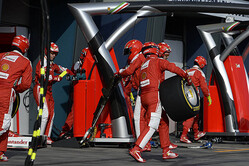


29/03/2016
NEWS STORY
 When revised regulations governing race weekend tyre allocations were announced for the 2016 season, it's fair to say that there was a reasonable degree of head scratching among both pundits and fans as to just how the new system would work.
When revised regulations governing race weekend tyre allocations were announced for the 2016 season, it's fair to say that there was a reasonable degree of head scratching among both pundits and fans as to just how the new system would work.
However, now the dust has settled from the opening race of the year in Melbourne, two things have become clear: first, that this latest tweak to the rules is not as complex in reality as it seems on paper; second, that it's working...
Why does making a third tyre compound available lead to greater strategic variation?
It's simple maths. If you pick three numbers, the quantity of different combinations in which they can be arranged is notably greater than if you had two to choose from. Likewise, having three tyres compounds available to each team over a race weekend has opened up two or three viable additional strategy options.
Did the availability of a third tyre compound have an effect on the race in Melbourne?
At the 2015 Australian Grand Prix, every driver was pushed into running a one-stop strategy - starting on the soft and finishing on the medium. And, had the same tyre choices been available in 2016, they would likely have done the same. The difference this year was that teams had the scope to run two or three different strategies that could potentially converge into a roughly similar solution at the end of the race, resulting in an interesting and unpredictable mix of one and two-stoppers. Even without the red flag, it would have been a very entertaining race.
What was the impact on the racing?
Melbourne saw more overtaking than in previous years - 40 overtakes compared to 13 in 2015 - and this is down in no small part to the new tyre regulations. At other circuits where it's tough to pass such as Barcelona, Monaco, Budapest or Singapore, track position will again become potentially less of a factor. With three compounds, the difference between the tyres can now create overtaking scenarios.
Was Melbourne a one-off or will this trend continue at other circuits?
There are already signs that more options will open up strategy-wise at the next race in Bahrain - and China looks set to be yet more exciting again. It will create exciting races where one strategy initially appears better than the other - but then that could flip. Whether more cars choose to run one, two or three stops is not important. What creates variation and excitement is that offset strategies are now perfectly valid potential race-winning options, leading to more overtaking and more unknowns towards the end of the race.
Of course, there's a fine line between interesting strategic differences and chaos. If teams had free choice of compounds for every race, there would be potential for someone to seriously distort the competitive order. The current concept, however, appears to have found the right balance between exciting but understandable racing.
What do the teams make of the change?
Pirelli have created a compound range that promotes excitement if deployed and promoted in the right way. The world wants to see teams and drivers trying to do things differently, and these regulations empower them to do so. Tyres are now a positive talking point before a race weekend. For example, the difference in Bahrain compound nominations between the Silver Arrows and Ferrari has attracted plenty of attention. What's more, by bringing softer compounds to each event, the target of making the cars faster has already been achieved in large part. In qualifying, lap times will now be close to circuit records in the manner we saw in Melbourne. The current cars possess historic highs of chassis and engine performance - and this is now being translated into the headline times.
Is there room for improvement?
As is to be expected, there are a couple of teething problems. For example, teams were asked to nominate their compound choices for a different set of regulations to those under which the sport is now operating for qualifying. But this is a minor complaint. Arguably, the change to the tyre rules has had more of an effect than any other in recent memory. The vast majority of people appear rather excited about its impact - and long may that continue.